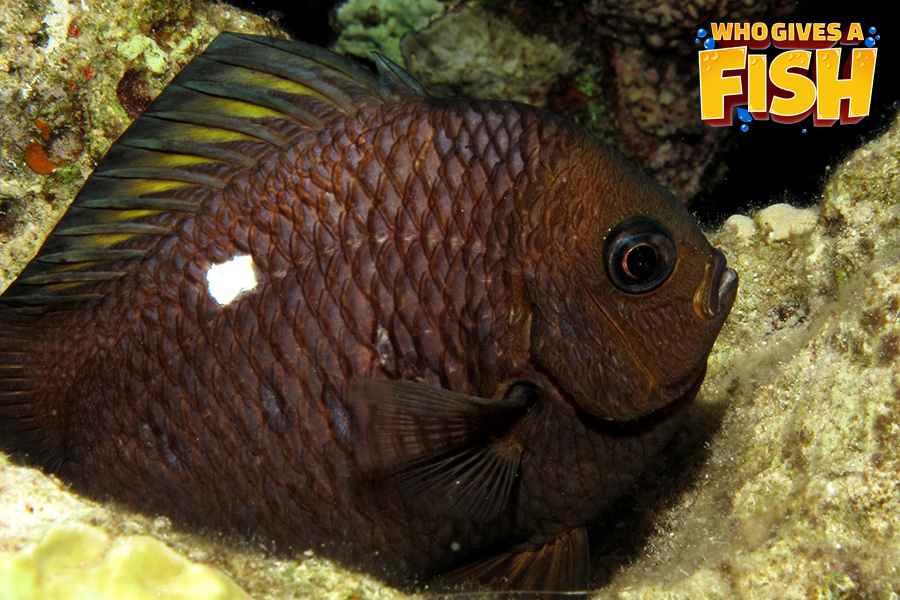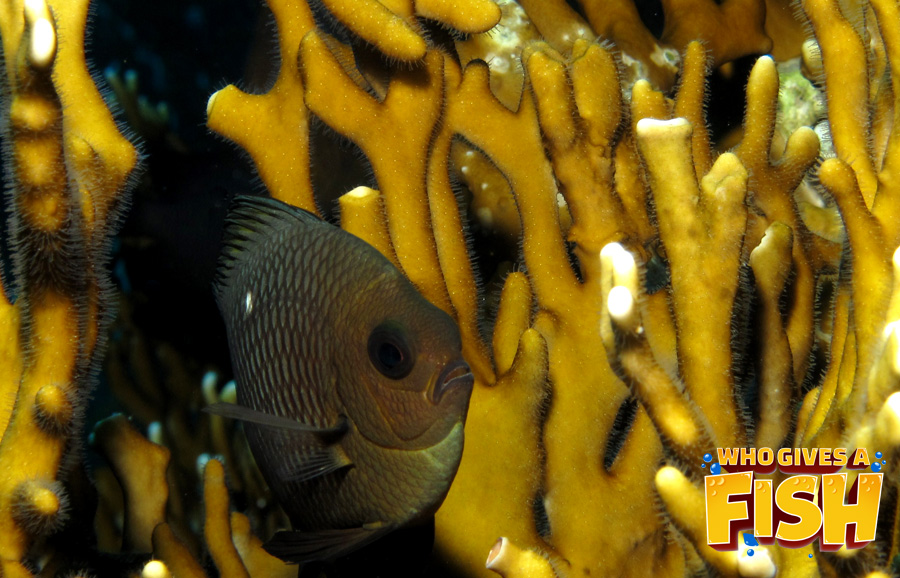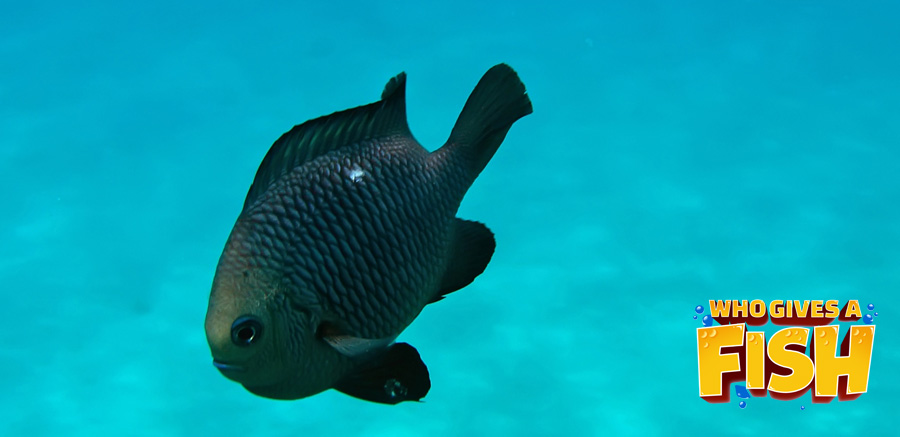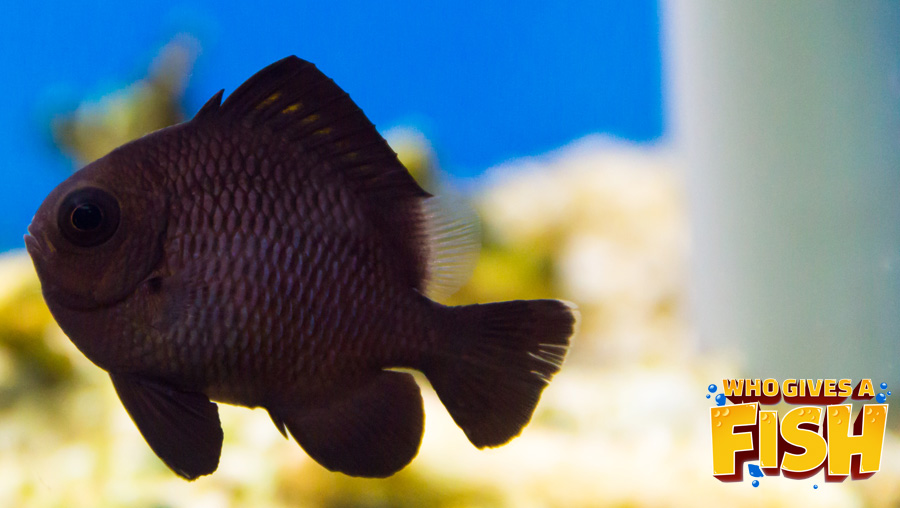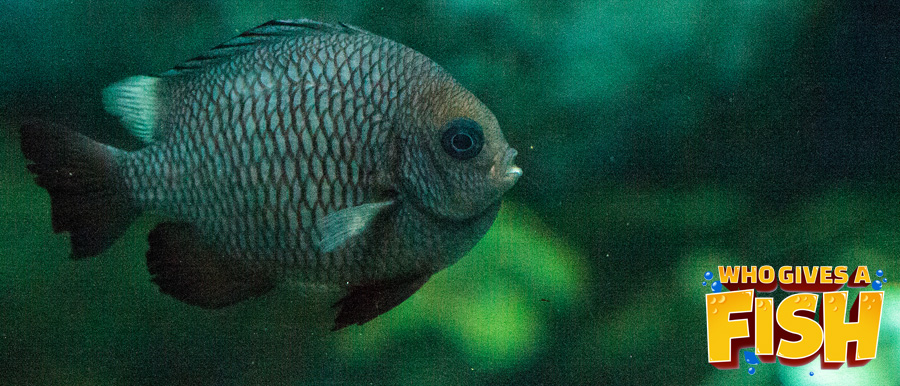Domino Damsel
The Domino Damsel, Dascyllus trimaculatus, is well known for being one of the most dashing Damselfish as a juvenile. It is a small black fish with a very distinct while spot on its forehead and another pronounced white spot on its upper side. This is how it has gotten its other names; the Three Spot Dascyllus and Three Spot Damsel. It is a stunning fish and catches the eye of viewers quickly.
- Experience Level: Beginner
- Hardiness: Very Hardy
- Minimum Tank Size: 60 gal (227 L)
- Size of fish: 5.5 inches (14 cm)
- Temperament: Aggressive
- Temperature: 72.0 to 82.0° F (22.2 to 27.8° C)
- pH Range: 8.1-8.4
- Diet: Omnivore
Table of Contents
Introduction
Aquarium Setup
Difficulty
Feeding
Breeding and Social
As the fish matures, the white marks will generally disappear and leave just a small remnant of the spots on the side. The colors of the fully-grown adults range from dark gray to light gray depending on where they are born and their lifestyle.
Individuals that are in breeding mode or being aggressive often tend to be lighter in color or even white. Interestingly, as they are feeding or being cleaned they will be a black or gray color. Reaching up to 5 ½ inches or 14cms in length, 5 inches is more likely to be seen in an aquarium.
These little damsels are like other damsels as they are hardy and easy to care for. Juveniles will be seen swimming together in large groups. As they mature, they will become more aggressive and territorial so become more solitary. This is something that needs to be taken into account in a home aquarium s they can cause problems with territories. If this fish has been added first, more aggressive fish added after will still be harassed by it. If this fish is to be kept as a mature adult, the tank needs to be setup right as they will fiercely protect their territories.
Like always, tank mates need to be chosen carefully with only one Domino Damsel being added per tank unless it is a very large tank. They shouldn’t be housed with other damsels. The tank should have other aggressive or semi-aggressive larger fish. Pairs need to be kept in larger tanks to avoids problems and injuries. Passive and peaceful fish will be attacked by this Damsel if the tank is too small.
A tank size of at least 55 gallons for one Domino Damsel is required with plenty of rock work for them to hide in. They are planktivorous fish who are always eating in the wild so need to be fed at least 3 times a day in a home aquarium. Feeding more regularly in the day helps avoid any aggressive problems in the tank with other fish. Juveniles will adjust well if provided with more hiding spots.
The Domino Damsel has a deep body and is not built for speed like the other Damselfish are known for. Because of this they tend to stay closer to a host coral. Distinct pulsing sounds can be heard when they are engaged in fighting or during spawning and protecting their nests. They can reach up to 5 ½ inches or 6cms in length although most only grow up to 5 inches in the home aquarium setting. They can live from 2-8 years in the wild and even up to 20 in captivity.
Juveniles will have black scales and blue in the center. Their fins will be black with a bluish color between their rays and dorsal fin. Their bodies will have 3 small white spots, 1 on the forehead and one on each side of their back, below their dorsal. This is how they got their dame the Domino Damsel.
A light gray to dark gray will be seen in the adults and the dots on the forehead disappear. Some of the white spots on their sides may stay though. Some fish found in the waters that are more turbid will have some red-orange on the fins and other parts of the body. During feeding, adults will have a black or gray coloring. Interestingly, during some social interactions like courtship, spawning and fighting, their bodes will turn a light gray or white in color with the eyes remaining black. Sometimes a black strip can be seen through the eyes.
The Domino Damsel it its natural habitat
Aquarium Setup
The Domino Damsel can be kept in both large saltwater reefs and smaller reefs. They will usually grow to around 5 inches but because of their deep bodied shape they need plenty of space to move about. A minimum tank size of 55 gallons is highly recommended for more than one Domino Damsel. Once mature they will become aggressive so adding them to the tank or adding other fish needs be thought out carefully. If you are to house a pair, ensure your tank is at least 75 gallons with plenty of hiding spaces.
Regular water parameters are required, with water temperatures between 72˚F to 82˚F (22 – 28˚C) and a pH of 8.1 to 8.4 to maintain happy and healthy fish. Like that of Clownfish, optimal spawning production occurs between 79°F to 83°F (26°C to 28°C).
Domino Damsel Aquarium Guide
- Minimum Tank Size: 60 gal (227 L) – A minimum of 60 gallons is required for a single fish.
- Suitable for Nano Tank: No
- Live Rock Requirement: Yes – Will hide in caves and secluded sections of rock-work.
- Substrate Type: Any
- Lighting Needs: Any
- Temperature: 72.0 to 82.0° F (22.2 to 27.8° C)
- Breeding Temperature: 79.0° F (26.1° C)
- Specific gravity: 1.023-1.025 SG
- pH Range: 8.1-8.4
- Brackish: No
- Water Movement: Any
- Water Region: All areas.
Difficulty
The Domino Damsel belongs to a group of easy fish to care for in the home aquarium. They are hardy little fish and great for both beginner and advanced hobbyists. They have simple requirements of being fed several times a day and having plenty of hiding places to dart into. Like other Damsels they are hardy but will fall ill when water conditions are poor for too long.
Juveniles are passive and can be kept in groups, but this will change as they mature. Adults will become aggressive and attack other damsels and other tankmates that are more passive in nature. A tank size of at least 55 gallons is needed with plenty of hiding spaces. Keeping this fish well comes down to feeding regularly in the day, plenty of rock and corals and maintaining water quality.
Feeding
These Domino Damselfish are known to be Omnivores. They will feed mostly on plankton in the wild and enjoy planktonic crustaceans and copepods. They will also eat benthic algae and weeds. As they consume these weeds, they will also ingest small crustaceans that are living in the algae covered surfaces.
They will be seen eating in the water column and around the top of the tank. These fish are eating constantly in the wild, so it is required that they are fed several times a day to replicate these habits. If feeding any pellets, ensure they are wet before adding to the tank to avoid air getting into fishes digestive tracts, causing problems.
Domino Damsel Feeding Guide
- Diet: Omnivore – Preference for planktonic crustaceans and algae.
- Flake Food: Yes
- Pellet / Tablet: Yes – Soak pellets in water before introducing to the tank.
- Live foods (fish, shrimp, worms): Occasionally offer varied live food into their diet.
- Vegetable Food: 10% of their diet
- Meaty Food: 90% of their diet
- Feeding Frequency: Several times per day. Keeping them well fed will curb any aggression.
Breeding
Males will be the larger and more dominant fish in the pair or the group of Domino Damselfish. They are all born as females and some females may even have some undeveloped male organs which allow them to switch to male much faster than others. If a dominant male disappears, these individuals will be the ones most likely to switch first and take over.
Amazingly, the Domino Damselfish has been successfully bred in captivity before, with a pattern that follows the Clownfish of spawning every 3 weeks. Be aware if breeding, that crabs, wrasses, serpent stars and brittle stars will eat the Domino Damsels fish’s eggs.
Successful breeding requires the right setup in the tank. Optimal spawning will occur between 79°F to 83°F (26°C to 28°C). Males will choose a suitable nesting site that will either be a flat rock, coral rubble, dead coral branches or in a rock crevice. In order to attract females, males will begin jumping and producing sounds. Signal jumping is where the fish dips up and down quickly. Once females see that males are ready to begin spawning, she may choose to join him. The pair can be seen swimming side by side and with the male slightly behind the females. They can also be seen swimming at each other from opposite directions. Once they are together, they will begin to turn nearly completely white, begin vibrating and then depositing their gametes. This process is then repeated every few minutes, with their regular colors returning once completed.
Once the eggs have been laid and fertilized, the male will begin to produce pulsing sounds while he defends the nest, which can hold over 1000 eggs. Males will oxygenate the eggs and remove any that become undeveloped. Like all he Damsels, males will then aggressively protect the nest until the eggs hatch. Hatching will occur in 2-2.5 days, with the larval stage lasting between 22-24 days
The Domino Damsel displaying it’s wonderful round, chubby shape
Social
The Domino Damselfish are quite aggressive once mature, but if compared to other damsels like the Fiji blue devil they are not so bad. Regardless, they are considered aggressive once mature, as opposed to juveniles who are very passive and can live in groups. Adults, especially males, will quickly take over a tank as the dominant fish and control the area. It is best to keep just one or one single pair in a tank
If tank mates are to be added, they should be larger and more aggressive fish to keep the Domino in line. Smaller more passive fish will quickly become harassed as the Domino takes control of the tank. If they are to be housed with smaller semi-aggressive fish (e.g. dwarf angelfish) then your tank size should be at least 100 gallons with plenty of rock work for hiding in.
If the tank is under 100 gallons, the best fish to house them with will be larger dottybacks, butterflyfish, larger angelfish and triggerfish. Like keeping other Damsels, ensure they are not housed with other fish that can swallow them whole, so don’t add any predatory fish. Dominos will also be quick to identify fish as predators, so may not come out of the rock work if they are present, leading to stress and starvation.
The Domino will go well in a reef tank and leave your corals alone. Some SPS colonies will actually benefit from their presence. Dominos have been known to be so defense over eggs, that newly added coral frags and been shaken and pushed over by the domino if placed to close to its nest.


